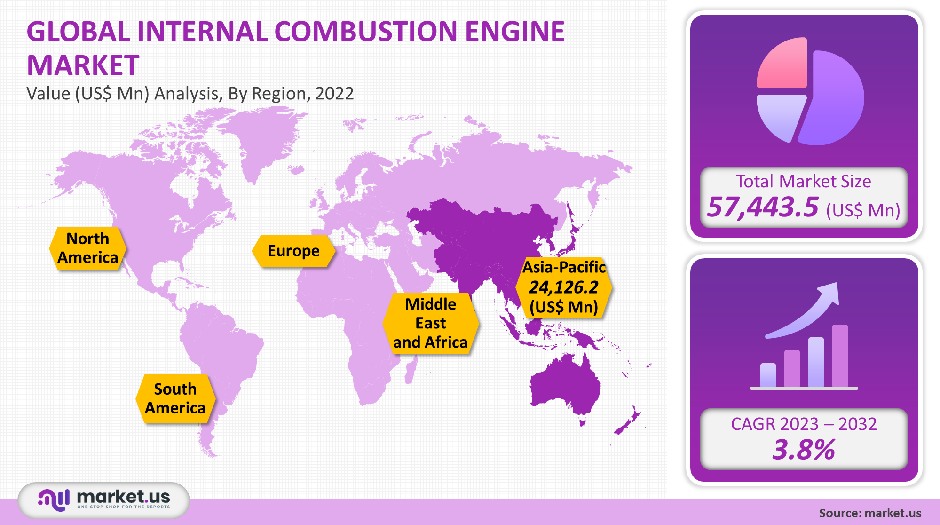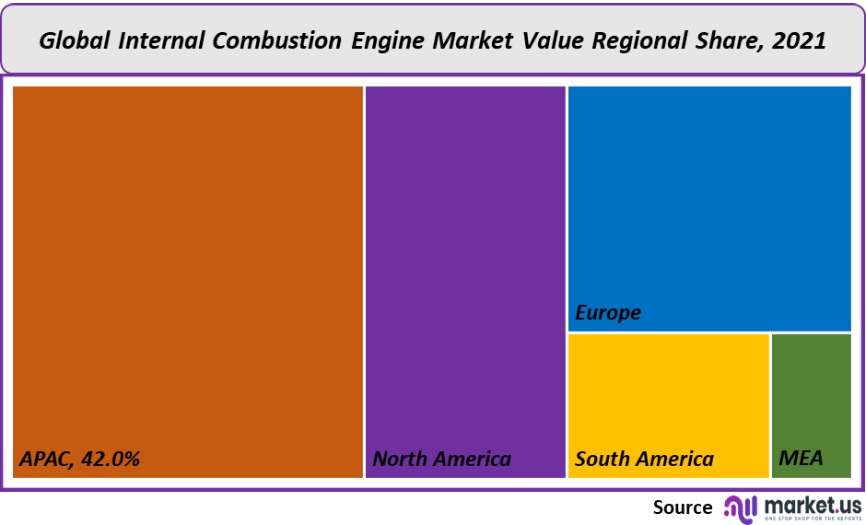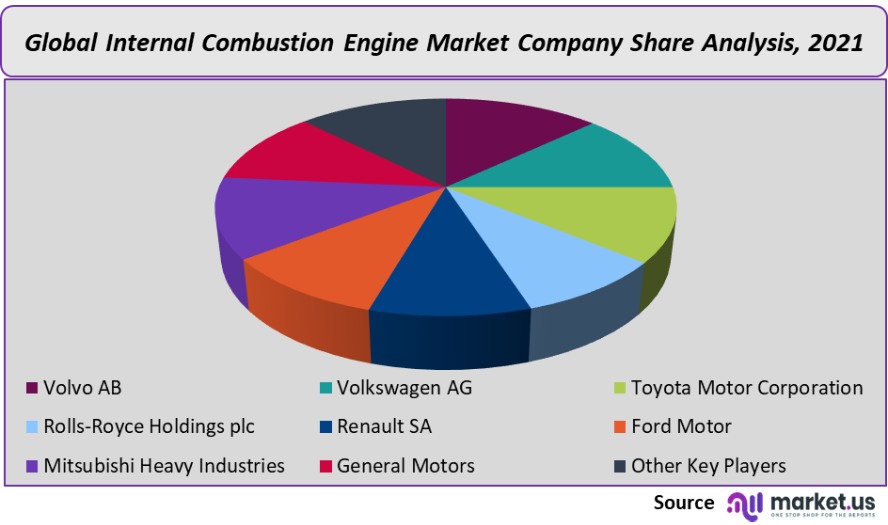Global Internal Combustion Engine Market By Fuel (Petroleum and Natural Gases), By End-Use (Automotive, Marine, and Aircraft), By Region and Companies - Industry Segment Outlook, Market Assessment, Competition Scenario, Trends and Forecast 2022-2032
- Published date: Oct 2021
- Report ID: 14459
- Number of Pages: 332
- Format:
- keyboard_arrow_up
Internal Combustion Engine Market Overview:
The global Internal Combustion Engine market was worth USD 57,443.5 million in 2021. It is projected to grow at a CAGR of 3.8% between 2023 and 2032.
This market has had its share of challenges over the years due to its dependence on existing limited fossil fuel reserves and the need for improved emission levels.
The recent introduction of advanced technologies like low-temperature combustion engines (LTC) and hybrid systems has helped the market gain momentum, which is expected to increase industry growth during the forecast period.
Global Internal Combustion Engine Market Scope:
Fuel Analysis
The ICE market can be segmented by fuel type into petroleum and natural gases. The market was dominated by the petroleum segment, which had a volume-based share exceeding 78.2% in 2021. It can further be divided into gasoline and diesel.
More than 45.0% of 2021’s overall volume was accounted for by gasoline engines. This is due to the many benefits that gasoline engines offer, including less noise and vibration and low fuel costs.
Natural gas, despite being abundant and having a substantial cost advantage, commanded a lower market share of the market in 2021. It will take many years for this fuel type to be widely adopted, as most cars run on gasoline or diesel. This segment is expected to see a 4.1% CAGR between 2023-2032.

End-Use Analysis
The internal combustion engine market can be segmented by end-use into marine, aircraft, and automotive. The segment automotive accounted for more than 65.0% of total volume in 2021 and will see the most rapid growth over the forecast period. This growth can be attributed to rising disposable income, which in turn leads to an increase in vehicle adoption around the world.
Over the next years, product demand will be boosted by technological advancements that result in improved IC engines in terms of fuel efficiency, emissions, and performance.
The growth of the aircraft ICE segment is expected to be moderate. It will grow at a CAGR of over 4.5% from 2021 through 2032. This segment is driven mainly by positive market dynamics that impact the commercial aviation industry.
Technological advancements, such as multifuel capability, that increases fuel mileage, could drive demand. According to the International Air Transport Association, there will be an increase of global passengers in 2030. The aviation industry will need to boost its output to meet this demand.
Маrkеt Ѕеgmеntѕ
By Fuel:
- Petroleum
- Diesel
- Gasoline
- Others
- Natural Gas
- CNG
- LNG
- Others
By End-Use:
- Automotive
- 50-200 HP
- 200-300 HP <300 HP
- Marine
- 258-1000 HP
- 400-1400 HP
- 730-1800 HP
- Aircraft
Market Dynamics:
IC engines have been combined with hybrid-electric powertrains to improve fuel economy, thanks to the introduction of electric vehicle technology. These engines can be combined with plug-in hybrid electric systems to increase the number of plug-in hybrid vehicles. These benefits are expected to offer opportunities for industry growth in the coming years.
The industry is required to comply with strict regulations regarding fuel economy, exhaust emissions, and engine design. This means that they must develop high-speed engines and high-power engines that meet customer needs and have minimal environmental impacts.
Despite all these efforts, many governments worldwide are pushing for IC engine bans, particularly in the automotive industry. The U.K. is planning to ban ICE sales by 2025, as are France, Norway, and India. China and Germany plan to enforce similar bans, but they have not given any specific time frame.
An optimistic scenario is that electric vehicles can live up to the expectations of the leading EV manufacturer. The timeframe established by countries to ban new IC engine sales could be realized. However, it is unlikely that IC engine sales will cease anytime soon. It will take a long time before EVs are widely adopted, largely due to the lack of sophisticated charging infrastructure in several countries and the high price of these vehicles.
The aviation industry’s production and shipping of aircraft directly affect the demand for an engine. Globally, internal combustion engines are in high demand due to increasing sales of passenger cars and commercial vehicles as well rising cargo ship and aircraft shipping.
Natural gas is becoming a more popular alternative fuel because of its lower vehicle emissions, lower costs, and easy availability. The advent of electric vehicles has seen internal combustion engines combined with a hybrid electric powertrain to increase fuel economy. To expand the PHEV portfolio, IC engines may be combined with plug-in hybrid electric systems. These benefits are expected to propel the overall market.
Rising disposable income will likely be a major driver of the global internal combustion engine market in the coming years. Their demand will rise due to the low cost of internal combustion engine purchases over the forecast period. This will drive up the demand for automobiles as consumers are more likely to spend. The demand for internal combustion engines will also be boosted by strong economic growth in Latin America, Asia, and Latin America.
Over the forecast period, the internal combustion engine market will grow due to rising maritime passengers and increasing marine transport business. The IC market will be able to take advantage of technological advancements, modern production processes, and increased research-and-development efforts in the sector.
Regional Analysis
The Asia Pacific is the largest regional market, accounting for over 42% of the global share. High automobile production in the region is responsible for this. The growth of the internal combustion engine market will be driven by emerging markets like India and China.
As India has many advantages, such as lower prices for raw materials and low labor costs, making in India is expected to attract significant investment in the automobile sector. China and India, which have large supply chains and logistic networks, are among the fastest-growing economies in the world. In the future, there will be a surge in demand for commercial cars due to the booming e-commerce market in the region.
North America will also see significant growth due to its high adoption rate. North America is home of major automotive manufacturers like Ford Motor Corporation and General Motors Company. The automakers constantly modify the size and shape of the ICE in an effort to make smaller and lighter engines that are more efficient. This is a positive factor in market growth.

Кеу Regions and Countries covered in the rероrt:
- North America
- US
- Canada
- Mexico
- Europe
- Germany
- UK
- France
- Italy
- Russia
- Spain
- Rest of Europe
- APAC
- China
- Japan
- South Korea
- India
- Rest of Asia-Pacific
- South America
- Brazil
- Argentina
- Rest of South America
- MEA
- GCC
- South Africa
- Israel
- Rest of MEA
Key Companies & Market share:
The global internal combustion engine market is characterized by well-established players. The key companies are Volvo AB and Toyota Motor Corporation, Volkswagen AG and Rolls-Royce Holdings plc., Toyota Motor Corporation, Renault SA, Ford Motor, General Motors, and Mitsubishi Heavy Industries.
The industry participants compete on price, market presence, and new product development. To increase market presence and gain a competitive edge, manufacturers tend to emphasize strengthening their global footprint.

Маrkеt Рlауеrѕ іnсludеd in the rероrt:
- Volvo AB
- Volkswagen AG
- Toyota Motor Corporation
- Rolls-Royce Holdings plc
- Renault SA
- Ford Motor
- Mitsubishi Heavy Industries
- General Motors
- Other Key Players
For the Internal Combustion Engine Market research study, the following years have been considered to estimate the market size:
Attribute Report Details Historical Years
2016-2020
Base Year
2021
Estimated Year
2022
Short Term Projection Year
2028
Projected Year
2023
Long Term Projection Year
2032
Report Coverage
Competitive Landscape, Revenue analysis, Company Share Analysis, Manufacturers Analysis, Volume by Manufacturers, Key Segments, Key company analysis, Market Trends, Distribution Channel, Market Dynamics, COVID-19 Impact Analysis, strategy for existing players to grab maximum market share, and more.
Regional Scope
North America, Europe, Asia-Pacific, South America, Middle East & Africa
Country Scope
United States, Canada and Mexico, Germany, France, UK, Russia and Italy, China, Japan, Korea, India and Southeast Asia, Brazil, Argentina, Colombia etc.Saudi Arabia, UAE, Egypt, Nigeria and South Africa
Frequently Asked Questions (FAQ)
Q: What is the Internal Combustion Engine market size?A: The Internal Combustion Engine market size is US$ 57,443.5 Million in 2021.
Q: What is the CAGR for the Internal Combustion Engine market?A: The Internal Combustion Engine market is expected to grow at a CAGR of 3.8% during 2023-2032.
Q: What are the segments covered in the Internal Combustion Engine market report?A: Market.US has segmented the Internal Combustion Engine market by geography (North America, Europe, APAC, South America, and the Middle East and Africa). By Fuel, the market has been further divided into Petroleum and Natural Gases, By End-Use, market has been segmented into Automotive, Marine, and Aircraft.
Q: Who are the key players in the Internal Combustion Engine market?A: Volvo AB, Volkswagen AG, Toyota Motor Corporation, Rolls-Royce Holdings plc, Renault SA, Ford Motor, Mitsubishi Heavy Industries, General Motors, Other Key Players, are the key vendors in the Internal Combustion Engine market.
Q: Which region is more attractive for vendors in the Internal Combustion Engine market?A: APAC is accounted for the highest revenue share of 42%. Therefore, APAC’s Internal Combustion Engine market is expected to garner significant business opportunities for the vendors during the forecast period.
Q: What are the key markets for Internal Combustion Engine?A: Key markets for Internal Combustion Engine are China, India, The US etc.
Q: Which segment has the largest share in the Internal Combustion Engine market?A: In the Internal Combustion Engine market, vendors should focus on grabbing business opportunities from the petroleum segment as it accounted for the largest market share in the base year.
![Internal Combustion Engine Market Internal Combustion Engine Market]() Internal Combustion Engine MarketPublished date: Oct 2021add_shopping_cartBuy Now get_appDownload Sample
Internal Combustion Engine MarketPublished date: Oct 2021add_shopping_cartBuy Now get_appDownload Sample - Petroleum
- Volvo AB Company Profile
- Volkswagen AG
- Toyota Motor Corporation
- Rolls-Royce Holdings plc
- Renault SA
- Ford Motor
- Mitsubishi Heavy Industries
- General Motors
- Other Key Players
- settingsSettings
Our Clients
|
Single User
$5,999
$2,999
USD / per unit
save 50% |
Multi User
$7,999
$3,499
USD / per unit
save 55% |
Corporate User
$12,999
$4,499
USD / per unit
save 65% | |
|---|---|---|---|
| e-Access | |||
| Data Set (Excel) | |||
| Company Profile Library Access | |||
| Interactive Dashboard | |||
| Free Custumization | No | up to 10 hrs work | up to 30 hrs work |
| Accessibility | 1 User | 2-5 User | Unlimited |
| Analyst Support | up to 20 hrs | up to 40 hrs | up to 50 hrs |
| Benefit | Up to 20% off on next purchase | Up to 25% off on next purchase | Up to 30% off on next purchase |
| Buy Now ($ 2,999) | Buy Now ($ 3,499) | Buy Now ($ 4,499) |









